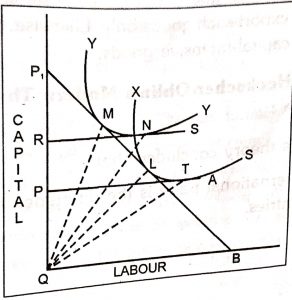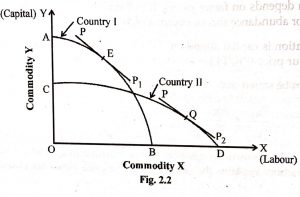Heckscher Ohlin Theory: Business Economics
Heckscher Ohlin theory | Heckscher Ohlin theory of international trade
- The principle of comparative cost advantage was based on the labour theory of value which itself was a defective theory as labour is not suitable measures the comparing cost of production due to the non-homogeneous function of labour.
- The drawback of the classical theory of international Trade induced the Swedish economist Prof. E. Heckscher (1991) to develop an alternate explanation of comparative advantage theory. His theory was further improved by his pupil Bertil Ohlin(1933). Hence it is known as the Heckscher-Ohlin theory.
- The Modern or Heckscher-Ohlin theory explains the new approach to comparative advantage on the basis of general value theory.
- From all the forces that work together in general equilibrium H-O theory isolate the difference in the physical availability or supply of factors of production among the nations to explain the difference in relative commodity prices and trade between the countries.
- According to the theory, “a nation will export the commodity whose production requires the intensive use of the nations relatively abundant and cheap factor and import commodity whose production requires intensive use of the nations relatively scarce and expensive factors”.
The following are assumptions of Heckscher Ohlin Theory:
- There are two countries each having two factors labour and capitals and producing two commodities
- There are two factors labour and capital
- There are two goods X and Y of which X is labour intensive and Y is capital intensive.
- Country A labour abundant and B country is capital-rich
- There are no transport cost to trade
- Full employment of factors exist in both economy
- Trade is free that is there is no trade restriction in the form of tariff and non-tariff barriers
- There is perfect competition in both commodity and factor market
- All the production function are homogeneous of the first degree that is produced is subject to constant returns to scale
- The two countries differ in factor supply
On the basis of the above assumptions, Ohlin’s theory states that a country exports goods which use relatively greater than the proportion of its relatively abundant and thus, cheap factors.

- In the diagram, xx and yy indicate iso-quants or equal product curves for two goods X and Y receptively.
- The line PA shows the relative factor price in country A and P1 B shows the relative factor price in country B.
- The line PA is tangent to xy isoquant yy at point T and P,B is tangent to isoquant at point M. Now line RS is drawn parallel to PA such that it becomes tangent to YY iso-quant at point N.
Factor Intensity:
The term factor intensity refers to commodity measurement in absolute terms. comparing the relative cost of the equal amounts of the two goods X and Y in Countries A and B, we find X is relatively cheaper in country A, and goods Y is relatively cheaper in country B. The Equilibrium factor proportion is OM for goods Y and OL for goods X in country A and OL for goods X and ON for goods Y in country B.
Factor Abundance:
The term factor abundance refers to factor endowments in relative terms. The labour abundant country has a comparative cost advantage in producing labour-intensive goods so with the opening of trade with the other country it must export such goods only. likewise, the capital abundant country must export capital intensive goods.
Conclusion:
In short Ohlin’s theory conclude that-
- The basis of international trade is the difference in commodity prices in the two countries.
- The difference in commodity price is due to cost differences, which the results of the difference in factor endowment in two countries.
- A capital-rich country specializes in capital-intensive goods and exports them, while labour abundant country specializes in labour-intensive goods and exports them.
Heckscher Ohlin theory, Heckscher Ohlin theory of international trade, Heckscher Ohlin theory of international trade pdf, Heckscher Ohlin theory diagram, Heckscher Ohlin theory pdf
For More Business Economic Notes Click Here
Reference: ML Jhingan, Economics Discussion


Sir I didn’t understand the first diagram
join on the app @9324646234